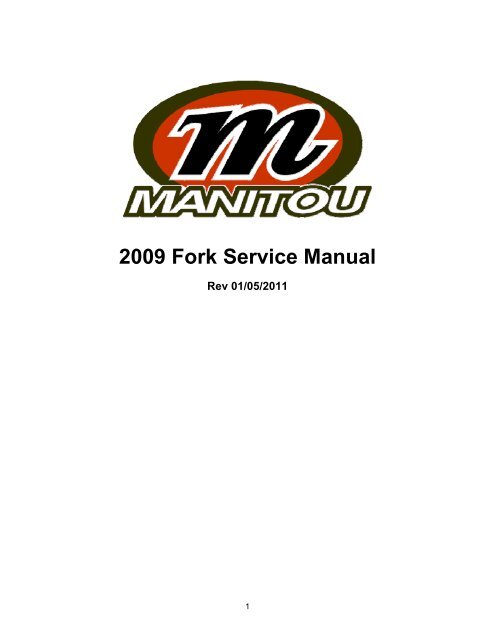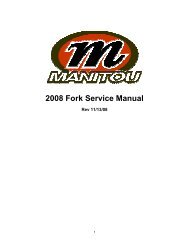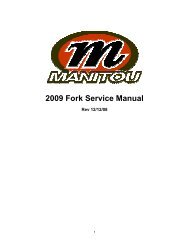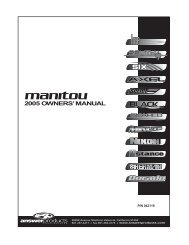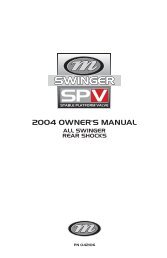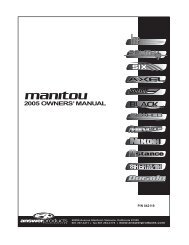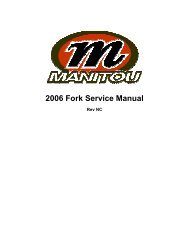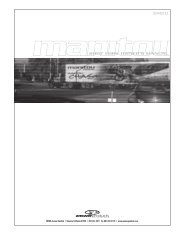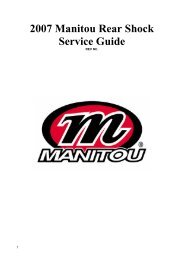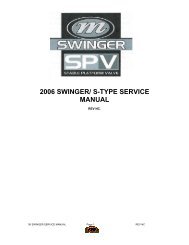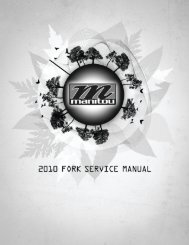Create successful ePaper yourself
Turn your PDF publications into a flip-book with our unique Google optimized e-Paper software.
<strong>2009</strong> <strong>Fork</strong> <strong>Service</strong> <strong>Manual</strong>Rev 01/05/20111
Table of ContentsDescriptionPageIntroduction and Suspension Terminology 1-7Section 1 - Disassembly/Assembly Instructions – Damping Systems 8-13Section 2 - Disassembly/Assembly Instructions – Spring Systems 14-21Section 3 - Disassembly/Assembly Instructions – Castings 22-23Troubleshooting Chart 21-22Technical Information – Oil Levels, Torque Specs, <strong>Fork</strong> Schematics 23-29Contact InformationHayes Bicycle Group6750 W Florist AveMilwaukee, WI 53218Toll Free: (888) 686-3472Direct: (262) 242-4300FAX: (414) 462-0214E-mail: manitoutech@hayesbicycle.comWeb site: www.manitoumtb.com2
INTRODUCTIONThis manual is intended to guide the user through basic service of <strong>Manitou</strong> front forks. <strong>Service</strong> issupported by the identification of common parts and assemblies that have been assembled into<strong>Service</strong> Kits. The purpose of this manual will be to describe conditions that may drive the needfor service and to provide installation instructions for the kits.Due to the time-consuming nature of suspension fork service, at this time our primary focus is tooffer service kits that minimize the amount of downtime and labor involved.Important information is highlighted in this manual by the following notations:WARNINGFailure to follow WARNING instructions could result in severe injury or death to theperson inspecting or repairing the suspension fork or the user.CAUTIONA CAUTION a caution indicates special precautions that must be taken to avoid damage tothe product.NOTEA NOTE provides key information to make procedures easier or clearerGENERAL WARNING: Suspension forks by design can contain preloaded springs, gasesand fluids under extreme pressure and warnings contained in this manual must beobserved to reduce the possibility of injury or possible death. Following theseinstructions can help you reduce the risk of being injured. Any questions in regards to theinformation in this manual should be directed to <strong>Manitou</strong> Customer <strong>Service</strong> at (888) 686-3472.WARNING: Suspension forks uses preloaded spring(s) to provide compression springresistance. This system must be relieved of preload prior to servicing. Failure to relieveair pressure could result in injury or possible death.CAUTION: Suspension forks use precision machined aluminum and other soft alloy components.Using correct tools for assembly is essential to prevent damage.3
FRONT SUSPENSION TERMINOLOGYAir Cap – Top cap that threads into top of air/spring leg (this is the left leg of the fork as you areseated on the seat). <strong>Fork</strong>s may be controlled with an air/spring or a coil spring. The air capcontains the Schrader Valve, which is used to control the spring rate or SAG of air forks.Air Spring – A mechanism that is used to control the SAG of an air fork.Arch – A support that connects the two outer lower legs of the casting so as to keep them movingin unison.Boss – The word used to describe an outer casting that has brake posts for V-brakes orcantilever brakes.Bottom Out Bumper – A rubber or elastomer device that absorbs the shock that occurs when asuspension is compression to its limit.Bushings – A cylindrical sleeve between a fork stanchion tube (inner leg) and a fork outercasting (slider), which facilitates the sliding movement between these two parts.Cartridge Damping – Provides better oil flow, bump sensitivity, and improved damping control inlong travel applications.Coil Spring – A coiled piece of metal that acts as a spring to help suspend a fork.Compression – The phase of the suspension operation in which the wheel travels up, or travelscloser to the frame. The suspension forks reaction to a bump in the trail.Compression Damping – Restriction of the rate that the suspension compresses under load.Crown Steer Assembly – the stanchion legs (inner legs), the fork crown, and the steer tubepressed together as one assembly. This assembly is then finished by adding all of the forkinternals and then outer casting (slider).Damping – A function that modifies the rate of suspension compression or rebound.Detent – An indentation that causes a rotating adjuster to stop at fixed increments.Drop Out – The end of an outer casting (slider) where the wheel attaches.Dust Boot – Usually a piece of rubber in the shape of a cylinder with baffles to allow it tocompress as the fork compresses through its travel. Its function is to help keep dirt and waterfrom getting into the inner legs of the fork.FRONT SUSPENSION TERMINOLOGY (CONT.)FFD – Fluid Flow Damping. A <strong>Manitou</strong> patented low cost oil damping system. The compressiondamping is non-adjustable and the rebound damping may be non-adjustable or adjustabledamping.<strong>Fork</strong> Crown – The component that joins the stanchion tubes (inner legs) to the steer tube of thefork.Hydraulic <strong>Fork</strong> Oil – Oil used in suspension designs to provide damping. It has specialcharacteristics that determine how it reacts when exposed to compressed air, how it changesviscosity when its temperature changes, and how it moves through valves.4
Hydraulic Lock Out – a condition caused when the mixture of air and damping oil is out ofbalance. It is caused when there is too little air space in a chamber, not allowing the fork tocompress through its travel.IS2 Integrated Stem System – integrates top triple clamp with bar mount, eliminating the needfor a stem. Flip Flop mount allows for 45mm or 60mm stem measurements and spacers allow barheight adjustments. Includes shims for both 31.8 and 25.4mm handlebars.Infinite Travel System (IT) – A handle-bar mounted air travel adjust system that allows the riderto change the fork travel (and ride height) without a spring rate change. The travel can bechanged from full compression to full rebound and at any place in between.Intrinsic Damping– speed sensitive SPV based damping system for long travel applications.Provides better sensitivity to small bumps and superior bottoming resistance.Lock Out – a special function that restricts the compression of the fork from moving. It isgenerally controlled by an external knob that is activated when a rider does not want the fork tomove, thus eliminating extra energy needed to overcome the bobbing forces of the fork.MCU – (Micro-Cellular Urethane) Special urethane that is filled with tiny air cells that act likesprings when the elastomer is compressed.No Boss - The word used to describe an outer casting that has no brake posts for V-brakes orcantilever brakes. This casting is to be used for disk brakes only.No Tools Hex Lock Axle – Update of patented Hex Lock through axle provides simple andeffective wheel removal system without requiring tools. Features dual quick release to removepinch pressure and the axle is tighten and loosened with hand turned side tension bolt.Oil Damping – A system that uses the resistance to oil flow through holes in a valve to provide ameans to alter the rate of suspension compression or rebound.Oil Level – The level of damping oil needed for the optimal damping performance of asuspension. It is measured as the air space distance between the top of the stanchion leg (innerleg) and the height of the oil inside of the leg. The fork must be completely extended in order toget an accurate measurement.O-Ring – A soft, flexible neoprene or Buna rubber ring with a round cross-section, which is usedfor sealing and retention.FRONT SUSPENSION TERMINOLOGY (CONT.)Oil Weight – A description of the relative viscosity of oil, such as hydraulic oil. Oil with low weightnumbers (5wt or 7wt) flows through the valving with less resistance than higher weight numbers(10or 15 wt).One Point Five Standard - 1.5 inch interface standard for frame head tubes, headset, cups,stem, and steer tubes which allows for the lightest weight and strongest design in 170mm singlecrown forks. This design greatly improves the control and steering precision of the fork. It is usedpredominately on forks with longer travel and the intended use is for more hardcore, extremeriding.Outer Casting – (see Slider)Preload – A condition of compressing a spring or elastomer before the operating loads are put onthe suspension, so that it provides a stiffer spring rate.5
Piston – In front suspension, the part of the damper that slides back and forth inside of thedamping leg that houses the valves. It can also refer to the air piston in the air/spring assemblythat slides back and forth compressing the air, thus causing a change in the spring rate of thesuspension.Porosity – The condition or property of having pores in a material that will allow gas or liquid topass through it.Quad Ring seal – New seal that replaces standard o-rings in designs that require more efficientair and oil sealing methods.Rebound – The phase of the suspension operation in which the wheel returns to its originalposition on the ground after compression.Rebound Damping – Restriction of the rate that the suspension rebounds when the compressionload is relived.Remote Lock out system – A handle-bar lever actuated system that controls the lock outfunction on front and rear suspension products.Reverse Arch Technology – Also known as RA. It is a system that is designed to move the archof a fork to the backside of a fork, rather than the conventional front position. It was designed toprovide greater rotational torque strength to an outer casting (slider), without adding additionalweight to the fork.Sag – The amount a suspension fork compresses at rest with a normal load (rider’s weight).Schrader Valve – Valve used to introduce air into a chamber.FRONT SUSPENSION TERMINOLOGY (CONT.)Seal – A part, usually neoprene rubber or Buna, that keeps contaminants out and/or workingfluids in.Semi Bath – A lubrication system that uses a lubricating oil to keep the bushing surface andstanchion legs (inner legs) as friction free as possible during movement of the stanchion legs.Spring Rate – The rate at which the resistance of a spring increases as it is compressed.Slider/Outer Casting – The tube (outer casting leg) of the suspension fork that0. remains fixed tothe wheel. It slides up and down on the stanchion leg (inner leg).Stanchion Clamps - (Double-Triple Clamps) the portions of the fork crown that clamp around thestanchion legs above and below the head tube of the bicycle frame on specific long travelapplications.Stanchion Legs – The suspension tube (inner leg) fixed to the fork crown. It remains stationaryduring the operation of the suspension.Steer Tube – The long cylindrical tube that extends from the top of the fork crown. Its function isto be inserted into the bicycle head tube and attach the suspension to the bicycle frame.Thru Axle – (Hex-lock) A device used for mounting a thru axle hub to special outer legs that arenot made for standard quick release hubs. <strong>Manitou</strong>’s Hex-lock (thru axle) system is a specialpatented system utilizing a hex shaped end that increases the stiffness of the fork and reducesslippage in the joint between the axle clamps and the axle.6
Top Out Bumper – A rubber, coil spring, or elastomer device that absorbs the shock that occurswhen the load is taken off a suspension so that it is allowed to rebound to its limitsTPC – (Twin Piston Chamber) a patented damping system that has independent pistons forrebound and compression. The system utilizes a mixture of air and oil in the damping leg of thefork to enhance the damping performance.TPC+ - A variation of TPC that has added a floating piston to the compression damper toenhance the performance of the compression damping under the load of bigger hits.Travel – The amount that a wheel moves between the most compressed and the most extendedstates of the suspensionViscosity – A description of how a liquid flows. Liquids with higher viscosity are thicker flow lesseasily or quickly than liquids with low viscosity. This has an affect on the damping speeds ofrebound and compression.Volume Control – A new system designed to work with SPV as a control of the compressionramp up rate of the fork. It has a range of adjustments from linear to very progressive.Wiper Seal – A rubber material that is used as a seal to keep dirt and water out of the outercasting legs. It is not designed to keep air pressure or extreme oil pressure in.7
Section 1: Damping SystemsAbsolute and TPC Damping System <strong>Service</strong>Disassembly Instructions for Absolute and TPC DampingFig. 1Fig. 2Fig. 31. First the rebound knob will need to be removed. Screw the rebound all the way in(clockwise), and then remove the 2mm hex screw inside the knob by turning itcounter- clockwise. Remove the knob by pulling gently away from the fork.2. Use an 8mm hex wrench to turn the damper shaft clockwise until it can be pushedinto the casting. (see Fig. 1)3. From the left leg dropout (Left when sitting on the bike), use a 10 or 11mm wrench toremove the compression rod screw.4. Remove crown/steer/inner leg assembly from the outer leg casting by pulling firmly onthe casting. The fork uses the Semi bath Lubrication system, use caution as the oilthat is in the casting will be released when the casting is removed, it is best to do thisover some type of catch pan.5. For forks with Absolute compression damping:a. Unscrew the 2mm Allen screw that holds the adjuster knob to the assemblyand remove the knob. There are two ball bearings sitting on top of springsunderneath the adjuster cap. Place those aside. Using a 24mm socketunscrew the Absolute assembly from the crown. Pull the assembly out of thefork leg. Fig 2 (Note: there will be a small amount of oil that comes outof the inner leg, when the assembly is pulled from the crown)6. For forks with TPC compression damping:a. Twist the knob all the way counter-clockwise to reduce the amount ofcompression damping on the system.b. Unscrew the 2mm Allen screw that holds the adjuster knob to the dampingassembly and remove the adjuster knob. There are two ball bearings sittingon top of springs underneath. Place those aside.c. Unscrew the compression assembly from the crown using a 20mm socket. Itmay be necessary to twist the assembly like you would be unscrewing ascrew and gently pull upward to free the assembly from the crown. Fig. 2(Note: there will be a small amount of oil that comes out of the inner leg,when the assembly is pulled from the crown)7. Turn fork upside down over drainage pan to empty Damping oil from the inner leg.Stroke the Damper shaft on the bottom of the inner leg 3-5 times to purge the leg ofoil that is caught below the Rebound piston.8. Unscrew Damper end cap from the bottom of the right leg and then carefully pull thedamping assembly out of inner leg. See Fig. 38
Assembly of Absolute and TPC Damping SystemWARNING When installing the outer Leg Casting to the Crown Steer Assy,Compression Rod bolts and Damper Shafts must be properly tightenedprior to use. Failure to do so could result in injury or possible death.9. Install the damping assembly into bottom of inner leg. Be sure to apply a thin layerof Prep M grease onto piston ring that is around the piston at top of assembly.Install the assembly and tighten end cap to specified torque value.NOTE: Proper torque of the damper cap to 92 - 115 Kg/Cm (80 - 100inlbs) iscritical; failure to tighten properly will result in system failure!10. Turn Crown/steer/leg assembly right side up, so that the crown of the assembly isfacing you. Extend the damping assembly all the way out and then pour damping oil(P/N: 85-0023) into the right inner leg. Fill leg about ¼ full. Take a rag and cover thetop of the right inner leg and then stroke the damping assembly up and down about5 times. This will insure that oil gets below the piston and not create an air space.11. Extend the damping assembly all the way out and then fill the inner leg to thespecified oil level in the Oil Heights Chart at the end of the manual.WARNING All top caps for Damper and Spring systems must be properlytightened prior to use. Failure to do so could result in injury or possible death.12. For forks with Absolute and TPC compression damping:a. Put a little bit of Prep M grease (Ref Answer Products PN 85-0031) on theglide ring or o-ring found on the lower piston of the assembly.b. Push the assembly into the fork leg and tighten down the top cap.c. Once the cap is tightened insert the springs into opposite holes in the topcap and then place the ball bearings on top of the springs (place a little dabof grease on spring to hold ball bearing in place).d. Place the adjuster knob onto the hex shaped aluminum shaft and seat itonto the top cap and ball bearing.e. Insert 2mm fixing screw and tighten to secure the knob. Compress the forkseveral times to circulate the oil through the system.15. Turn completed crown/steer/leg assembly upside down, so that the compressionrod and damper shaft are facing you. You will see a bottom out bumper on thedamper shaft; slide this bumper down towards the end cap that is threaded into theinner leg. This will help in keeping the shaft extended as you install the outercasting.16. Replace the o-ring at the end of the rebound shaft, if not you will risk having a leakin that area.17. Extend the rebound damper out from end cap as far as it will go and then slidebottom out bumper towards the end cap as far as it will go. The bumper will help tohold the damper shaft in place as you are inserting the inner legs into the casting.18. Press inner legs into casting about half way and then inject Semi Bath oil (5/40wt.synthetic oil, P/N: 85-0022) into outer casting, holding fork at 45 degree angle to theground with bottom of fork in the air (drop outs up). Inject 16cc’s of oil into eachouter leg. It is recommended to use a syringe to inject oil.19. Press inner leg assembly into outer leg casting until damper shaft contacts casting.Adjuster hex shaft should protrude slightly from casting.20. Use an 8mm hex wrench to turn the damper shaft counterclockwise, threading itinto the casting. Tighten to 3.4-4.5 Nm (30-40 in-lb)..21. Install rebound adjuster knob if applicable. Knob should turn uninhibited until theindicator is stopped by the casting9
Removal Coil Spring AssemblySection 2: Spring SystemsCoil Spring <strong>Service</strong> Instructions1. For Drake coil fork.Fig. 1Fig. 2Fig. 3a. Using a 20mm socket remove the top cap from the fork.b. Remove the spring from the fork. (Fig. 1)For a complete teardown of the spring system including the compression rod:1. You must remove the outer casting from the inner legs:a. From the left leg dropout (Left when sitting on the bike), use a 10 or 11mmwrench to remove the compression rod screw.b. From the right leg dropout, if the fork has adjustable rebound, the knob willneed to be removed. Screw the rebound all the way in (clockwise), and thenremove the 2mm hex screw inside the knob by turning it counter clockwise.Remove the knob by pulling gently away from the fork Use an 8mm hexwrench to turn the damper clockwise until it can be pushed into the casting.(See Fig. 2)c. Remove crown/steer/inner leg assembly from the outer leg casting by pullingfirmly on the casting. If the fork uses the Semi-bath Lubrication system, usecaution as the oil that is in the casting will be released when the casting isremoved.d. Then remove the end cap from the bottom of the left leg and remove thecompression rod and spring through the bottom of the leg. (See Fig. 3).2. Turn the fork over, rotate the preload adjuster on top left of fork crowncounterclockwise until it stops. This will reset the preload in the lowest tension settingwhen you rebuild the fork.3. Remove the adjuster knob from the top of the Pre-Load adjuster assembly on the topof the crown on the left side of the fork, by unscrewing the 2mm Allen head screw.4. Unscrew the assembly from the crown and then pull it out of the inner leg.Installing Coil Spring Assembly1. Reassemble the compression rod assembly and install in the fork leg.2. Generously grease the spring and insert it into the inner leg. The spring needs to seatonto the top of the compression rod. (See Fig. 4)3. Install the adjuster knob and 2mm hex screw.4. Press inner legs into casting about half way and then inject Semi Bath oil (5/40wt.synthetic oil, P/N: 85-0022) into outer casting, holding fork at 45 degree angle to theground with bottom of fork in the air (drop outs up). Inject 16cc’s of oil into each outerleg. It is recommended to use a syringe to inject oil.5. Press inner leg assembly into outer leg casting until damper shaft contacts casting.Adjuster hex shaft should protrude slightly from casting.6. Use an 8mm hex wrench to turn the damper shaft counterclockwise, threading it intothe casting. Tighten per the Schematic and Torque Specification Table for your fork.7. Install rebound adjuster knob if applicable.8. Install the compression rod screw and tighten per the Schematic and TorqueFig. 410
MARS Air Spring System <strong>Service</strong> InstructionsRemoval of Air Spring and Compression Rod AssemblyWARNING This fork uses compressed air to provide spring resistance andmust be relieved of pressure prior to servicing. Failure to relieve air pressurecould result in injury or possible death.Fig. 1Fig. 2Fig. 31. Remove all of the air pressure from the Schrader valve on top of the crown on the leftside (Black top cap), by depressing the Schrader valve. Be sure to hold fork with the topof the crown facing upwards. Note: When the air is released, there is a mixture of the oiland air inside the leg that maybe discharged.2. If you have not removed the Outer casting follow these instructions, then proceed tonext step:a. From the left leg dropout (Left when sitting on the bike), use a 10 or 11mmwrench to remove the compression rod screw.b. From the right leg dropout, if the fork has adjustable rebound, the knob willneed to be removed. Screw the rebound all the way in (clockwise) removethe 2mm hex screw inside the knob by turning it counter clockwise. Removethe knob by pulling gently away from the fork.c. Use a 8mm hex wrench to turn the damper clockwise until it can be pushedinto the casting. (see Fig. 1)d. Remove crown/steer/inner leg assembly from the outer leg casting by pullingfirmly on the casting. If the fork uses the Semi bath Lubrication system, usecaution as the oil that is in the casting will be released when the casting isremoved, it is best to do this over some type of catch pan.3. Unscrew the end cap on the bottom of the inner leg and remove compression rodassembly. (see Fig. 2) This will consist of a compression rod, bottom and top outbumpers, the end cap, and should be followed by a coil spring and then the air pushrod. (see Fig. 3) This spring is the one that would be changed if the fork’s SAG neededto be changed beyond the capabilities of the air pressure.To remove the air piston from the inner leg:1. Remove air dust cap covering the Schrader valve.2. Depress Schrader valve to release air pressure.3. Remove air cap on top of Left leg with 20mm socket.4. Remove left leg end cap and compression rod assembly from inner left leg. Thenremove spring and Air piston rod.5. Use a long narrow rod approximately 18”/458mm long and no greater than¼”/7mm in diameter and insert it into the left inner leg from the bottom of the leg.Be sure to direct the rod through the center of the negative spring assembly thatis about halfway up the inner leg.6. Once the rod has contacted the air piston, use a rubber mallet and tap the pistonout through the top of the inner leg. Caution: Do not allow rod used for pushingpiston out to contact the inside wall of inner leg during procedure, the surface ofthe leg could be damaged.11
R7 Air System <strong>Service</strong> InstructionsWARNING This fork uses compressed air to provide spring resistance andmust be relieved of pressure prior to servicing. Failure to relieve air pressurecould result in injury or possible death.Removal of Air Piston and Compression Rod AssemblyFig. 11. Remove air dust cap covering the Schrader valve.2. Depress Schrader valve to release air pressure.3. Remove air cap on top of Left leg with 20mm socket.4. Remove rebound adjuster knob using a 2mm hex wrench.5. From the right leg dropout, use 8mm hex wrench to turn the damper shaftclockwise until it can be pushed into the casting. (Fig. 1)6. Remove 11mm hex bolt (Compression Rod bolt) from bottom of Left leg.7. Remove crown/steer/inner leg assembly from the outer leg casting.8. Remove the end cap on the Left inner leg and remove Compression rod/negative spring assembly. (Fig. 2)9. Push the Air Piston out of the top of the leg by pushing on the CompressionRod. You may need to use a screwdriver placed in the end of the CompressionRod to fully remove it from the leg as the leg is longer than the Comp Rod.Fig. 2Installation of the Air Piston for R7 <strong>Fork</strong>sFig. 37. Apply a small amount of Prep M grease onto the threads at the top of the leftinner leg with your finger.8. Apply a small amount of Prep M grease around the outside diameter of the newair piston.9. Insert the air piston, larger cupped side up (the end with the glide ring goes up,See Fig. 3) into the inner leg through the threaded area at the top of the inner leg.Use your fingers to push the piston past the threads into the leg.10. Using a long screwdriver or rod, push the piston fully into leg sp that is in contactwith the Compression Rod.11. Pour about 3cc of a 40wt or greater automotive oil into the top of the piston andthen install the air cap assembly. Tighten per the Fastener and Torque Valuessection***Use a shock pump (p/n 85-4069) to fill the air system to the recommended levels asoutlined in the R7 Fastener and Torque Values Chart in the back of this manual12
Assembly Instructions.Installation of Air Piston and Compression Rod Assembly for R7<strong>Fork</strong>sWARNING All leg caps for Damper and Spring systems must be properlytightened prior to use. Failure to do so could result in injury or possible death.Fig. 4Fig. 5WARNING When installing the outer Leg Casting to the Crown Steer Assy,Compression Rod bolts and Damper Shafts must be properly tightened prior touse. Failure to do so could result in injury or possible death.1. Re-install the Compression rod, Negative spring (that has been well greased),and end cap. Torque the end cap to 35-50 in-lbs. (Fig.4 )2. Apply a small amount of Prep M grease onto the threads at the top of the leftinner leg with your finger.1. Apply a small amount of Prep M grease around the outside diameter of the newair piston.2. Insert the air piston, larger cupped side up (the end with the glide ring goes up,See Fig. 3) into the inner leg through the threaded area at the top of the inner leg.Use your fingers to push the piston past the threads into the leg.3. Using a long screwdriver or rod, push the piston fully into leg so that is in contactwith the Compression Rod.4. Pour about 3cc of a 40wt or greater automotive oil into the top of the piston andthen install the air cap assembly. Tighten per the Fastener and Torque Valuessection.5. Fully extend the damper shaft and slide the rubber bumper and spacers againstthe inner leg end cap, also slide the rubber bumper and spacers down to the endof the inner leg on the Compression Rod. Lightly grease the bushings on theinside of the outer leg casting using a thick grease such as Motorex Bike Grease2000. Insert the crown/steer assembly into the outer legs to the upper bushing.6. Push the outer legs past the lower bushing and reinstall the 4mm bolt and tighten8mm damper fitting in a counterclockwise direction. (See Fig. 5) Tighten perthe Fastener and Torque Values section.***Use a shock pump (p/n 85-4069) to fill the air system to the recommendedlevels as outlined in the R7 Fastener and Torque Values.13
IT Air System <strong>Service</strong> InstructionsRemoval of IT Air Spring and Travel Adjust AssemblyWARNING This fork uses compressed air to provide spring resistance and must berelieved of pressure prior to servicing. Failure to relieve air pressure could resultin injury or possible death.Fig. 1Fig. 2Fig. 3Fig. 41. Important: You must remove all of the air from the left leg of the fork beforedisassembling the IT System. It is advisable to have the fork inverted and pointedaway from your face, as there may also be a discharge of a mixture of air and oilwhen you depress the Schrader valve core (this is similar to the discharge when youdepress the valve core on any of the <strong>Manitou</strong> Air or SPV forks).2. On the bottom of the left leg (leg that has the Disk Brakes mounts on it), there is aSchrader valve protruding from it. Unscrew the valve cap and follow either of thesetwo methods for releasing all of the air from the system. (See Fig. 1)3. Depress the valve core and let all of the air out. Now depress the IT lever on thebike’s handlebar and release it. Once again, depress valve core in the Schrader valveto release any air in the leg. Do this a couple of times, until all of the air is released.If you have a helper, have them hold the IT lever on the handlebar down as youdepress the valve core. This will let all of the air out at one time.4. Now that all of the air is released, Remove the casting:a. From the left leg dropout (Left when sitting on the bike), use a 12mm wrench toremove the compression rod nut.b. From the right leg dropout, remove the rebound knob. Screw the rebound all theway in (clockwise), remove the 2mm hex screw inside the knob by turning itcounter clockwise. Remove the knob by pulling gently away from the fork.c. Use a 8mm hex wrench to turn the damper clockwise until it can be pushed intothe casting. (see Fig. 2)d. Remove crown/steer/inner leg assembly from the outer leg casting by pullingfirmly on the casting. The fork uses a Semi bath Lubrication system, use cautionas the oil that is in the casting will be released when the casting is removed, it isbest to do this over some type of catch pan.5. Use an Adjustable Wrench and unscrew the black end cap that is threaded into thebottom of the left inner leg. (See Fig. 3)6. Pull the lower IT assembly from the inner leg. There may be a small amount of oil thatcomes out of the inner leg as you remove the lower IT assembly. This is thelubricating oil used to allow the air piston on the lower shaft assembly to move freely.7. Now it is time to remove the IT upper assembly. Release the IT control wire from thecontrol lever (if attached) by unscrewing the fixing screw on the lever that holds thecable tight. Use a 2mm Allen Wrench to unscrew this screw and then pull the cableout of the lever.8. To remove the upper IT assembly, use a slotted 22mm 6 point socket (P/N: 83-2503),a 22mm Open End wrench, or an adjustable wrench. Unscrew it by turning counterclockwise.Note: Be aware of the IT control Wire spinning around whenunscrewing the top cap (See Fig. 4)9. Pull the upper assembly out of the inner leg.O-ringsFig. 515
Assembly InstructionsTroubleshooting Tips** If the fork starts to lose travel from an extended position to a shorter position by itself,the damage is most likely centered on the Quad ring around the outside of the piston.Fig. 6**If the fork extends from a shorter travel to a longer travel by itself, the failure can beinvolving the smaller Quad ring that is located under the piston on the inside diameter of itwhere the shaft of the upper assembly intersects the lower assembly and piston. Theshaft is sealed against leakage at this point to define the two different chambers. (Fig. 5)Always check two things when you have the system apart.**Use a straight edge and lay it next to the inner shaft that is attached to the top cap of theupper assembly to insure that that shaft is not bowed at any point. We found that in theassembly of these pieces, the shaft is pressed into the top cap and occasionally if it isover-pressed, the shaft will bow. This means that, where the bow is in the travel of theshaft, it will cause the Quad ring that it is passing through, to distort. Thus air transfersfrom one chamber to the other and the fork will extend by itself. If this is the case, you willneed a new top assembly and an O-ring kit. (Refer to Figure 6)Fig. 7**Make sure that the valve core in the Schrader valve is tight and does not stick open orclosed. If this is faulty, replace this valve core with a new one. Any bicycle tube valve corewill work, as well as any valve cores that we currently use on any of our other products.Note: Always replace all o-rings and seals provided in the IT O-ring kit, each timeyou take the system apart, this will insure that you receive maximum performance.Installation of the IT Control WireFig. 8Fig. 91. In order to change the inner control wire, start by following IT disassembly steps 1, 2, 6, 7,& 8.2. Once you have the upper assembly out of the fork, use the adjustable wrench and the12mm Open End wrench to unscrew the top cap from the shaft of the assembly. Refer toFigure 7 at the right.3. As you unscrew the top cap, you will feel a little tension created by a spring that is underthe cap. Separate the top cap from the shaft once you have completely unthreaded thetwo pieces.4. Pull on the inner wire in order to remove the machined stopper with the cable end in itfrom the shaft.5. You can now unhook the cable from the stopper and from the cable head end, pull thecable through the spring, the top cap, and the outer cable housing. Refer to Figure 8 atthe right.6. Reverse the above steps to replace the cable.Note: The inner cable can be replaced with a standard bicycle derailleur cableIt is recommended to replace the two O-rings on the stopper each time that it isremoved from the shaft, in addition to the Black Buna O-ring that is on the shaftbelow the threads.Replacement of Piston Quad Rings1. Refer to Figure 10 for wrench placement. Hold the 12mm wrench in place on the flats thatare on the piston seat and turn the piston with the adjustable wrench in a counterclockwise motion to unscrew the piston from the shaft.2. Once the piston is off of the shaft, you will see a small Black Quad ring inside the top ofthe shaft that you just unscrewed the piston from. Replace this Quad ring with a new onefrom IT O-ring kit. Be sure that the new quad seal is seated in the shaft and rests flatagainst the shelf inside of the shaft. (Refer to Figure 9)3. Install the Air Piston back onto the shaft in the reverse of the way you removed it. Tightenthe piston to 15inlbs (1.7Nm) onto the shaft.4. Remove the large Quad ring on the outside of the piston, Discard this Quad ring andreplace it with a new one. Be careful not to twist it in the groove that it rests in.16
Assembly InstructionsFig. 10Fig. 11Installation of the IT Air Spring and Travel Adjust AssemblyWARNING All leg caps for Damper and Spring systems must be properly tightenedprior to use. Failure to do so could result in injury or possible death.WARNING When installing the outer Leg Casting to the Crown Steer Assy,Compression Rod bolts and Damper Shafts must be properly tightened prior to use.Failure to do so could result in injury or possible death.1. It is recommended that when reassembling the IT system that you start by installing thelower assembly into the bottom of the inner leg first. Be sure to apply a small amount ofPrep M grease to the Quad ring on the outside of the piston, in the hole in the piston andonto the threads of the inner leg before inserting the assembly into leg.2. Twist the shaft assembly as you insert piston past the threads of inner leg. Tighten endcap to 25-35inlbs (2.8-3.9Nm). It might be necessary to use a socket and extension thruthe top of the fork leg and engage the head on the top of the piston so that you can screwin the quad seal past the threads in the leg.3. Put a small amount of Motorex grease on the end of the Upper Assembly shaft, and theninsert the assembly into the fork inner leg.4. As soon as contact is made with the hole in the top of the air piston/lower assembly, twistthe upper assembly like screwing in a screw to guide the upper assembly shaft into thehole without damaging the Quad ring seal in the shaft of the lower assembly.5. After reinserting the upper assembly into the fork but before screwing the top cap in, pourabout 8-10cc’s of Air Piston Oil (40wt. automotive oil maybe substituted) into the fork legthrough the top of the crown.6. Torque the top cap to 60-80 in/lbs using the slotted 22mm socket.7. Replace the Outer Casting if it has been removed as follows:a. Replace the o-ring at the end of the rebound shaft, if not you will risk having aleak in that area.b. Extend the rebound damper out from end cap as far as it will go and then slidebottom out bumper towards the end cap as far as it will go. The bumper will helpto hold the damper shaft in place as you are inserting the inner legs into thecasting.c. Press inner legs into casting about half way and then inject Semi Bath oil (5/40wt.synthetic oil, P/N: 85-0022) into outer casting, holding fork at 45 degree angle tothe ground with bottom of fork in the air (drop outs up). Inject 16cc’s of oil intoeach outer leg. It is recommended to use a syringe to inject oil.d. Press inner leg assembly into outer leg casting until damper shaft contactscasting. Adjuster hex shaft should protrude slightly from casting.e. Use an 8mm hex wrench to turn the damper shaft counterclockwise, threading itinto the casting. (See fig. 10) Tighten per the Schematic and TorqueSpecification Table for your fork.f. Install rebound adjuster knob if applicable.g. Install the compression rod screw and tighten per the Black Schematic andTorque Specification Table.8. Feed the inner wire through the cable housing and secure one end of the of the housinginto the gold cable guide, then feed the end of the inner wire through the hole in the blackcable stop on the lever.9. The inner wire now feeds through the hole in bottom of the lever, over the top of the leverand through the hole in the back of the lever.10. Pull the inner wire until there is no slack in the cable. Be sure to set a 2mm gap betweenthe front of the lever and the top of the cable stop to insure that you have not overtightened the cable before you tighten the 2mm Allen bolt on the front of the lever to cinchthe inner wire. (Refer to Figure 11)11. The last step is to cut the inner wire that is left hanging on the backside of the lever andthen installing the cable end to prevent it from fraying.12. Pressurize the system and check for proper function. It is fastest if you have someonedepress the control lever and hold it while you pump air into the system. This way thesystem equalizes immediately. If you do not have a second person to help, just add air tothe system and then periodically depress the lever to equalize the pressure.17
Section 3: Outer Casting <strong>Service</strong>Fig. 11. From the left leg dropout (Left when sitting on the bike), use a 10 or 11mm wrench toremove the compression rod screw.2. From the right leg dropout, if the fork has adjustable rebound, the knob will need to beremoved. Screw the rebound all the way in (clockwise) remove the 2mm hex screwinside the knob by turning it counter clockwise. Remove the knob by pulling gentlyaway from the fork.3. Use a 8mm hex wrench to turn the damper clockwise until it can be pushed into thecasting. (see Fig. 1)4. Remove crown/steer/inner leg assembly from the outer leg casting by pulling firmly onthe casting. If the fork uses the Semi bath Lubrication system, use caution as the oilthat is in the casting will be released when the casting is removed, it is best to do thisover some type of catch pan.Changing the Dust SealsFig. 2Fig. 31. To remove the dust seals, first remove the seal tension springs (otherwise they willget damaged), then take a large flat-bladed screwdriver and insert the tip between thebottom of the seal and the top of the foam wiper. (see Fig. 2)2. Push down on the screwdriver. This will pop the seal out of the casting. Next removethe foam oil ring. (see Fig. 3)3. Oil the foam rings (new or after cleaning the old rings) with a small amount of semibathoil and place them in the top of the casting above the Upper Bushings. (see Fig.4)4. Install the dust seal into the leg, use a large socket or piece of round tubing that islarge enough in diameter to press on the outside shoulder of the seal rather thanputting pressure on the sealing lip and spring so that they are not damaged. Repeatsteps 1-4 for the opposite fork leg. (see Fig. 5)Fig. 4Fig. 518
Assembly InstructionsWARNING When installing the outer Leg Casting to the Crown Steer Assy,Compression Rod bolts and Damper Shafts must be properly tightenedprior to use. Failure to do so could result in injury or possible death.Fig. 21. Turn completed crown/steer/leg assembly upside down, so that the compression rod anddamper shaft are facing you. You will see a bottom out bumper on the damper shaft; slidethis bumper down towards the end cap that is threaded into the inner leg. This will help inkeeping the shaft extended as you install the outer casting. (See Fig. 2)2. Replace the o-ring at the end of the rebound shaft, if not you will risk having an oil leak inthat area. (See Fig. 3)3. Extend the rebound damper out from end cap as far as it will go and then slide bottom outbumper towards the end cap as far as it will go. The bumper will help to hold the dampershaft in place as you are inserting the inner legs into the casting.4. Press inner legs into casting about half way and then inject Semi Bath oil (5/40wt.synthetic oil, P/N: 85-0022) into outer casting, holding fork at 45 degree angle to theground with bottom of fork in the air (drop outs up). Inject semi bath oil into each outer leg(See chart for correct amount). It is recommended to use a syringe to inject oil. (See Fig.4)5. Press inner leg assembly into outer leg casting until damper shaft contacts casting.Adjuster hex shaft should protrude slightly from casting.6. Use an 8mm hex wrench to turn the damper shaft counterclockwise, threading it into thecasting. Tighten per the Schematic and Torque Specification Table for your fork.7. Install rebound adjuster knob if applicable.8. Install the compression rod screw and tighten per the Schematic and Torque SpecificationTable.Fig.Fig. 3Use: 8mm Allen wrench, 2mm Allen wrench, 11mm Nut Driver or open end wrench,Syringe for Semi Bath Oil, Air pumpFig. 419
32mm Leg Thru Axle InstructionsRemoval InstructionsRemoval of Hex Thru Axle1. Loosen the two 3mm clamp-fixing bolts on the right fork leg. (See Fig. 1)2. Remove the Thru Axle nut from the right side of the Thru axle.3. Loosen the two 3mm clamp-fixing bolts on the left fork leg.4. Push the Hex Thru Axle out of the dropouts from left to right and completely remove itand the front wheel from the fork.Fig. 1Assembly InstructionsInstallation of Hex Thru AxleFig. 21. Insert the Clamp Nuts (See Fig.3 – A) into the small hexagonal hole in each of thedropouts.2. Insert 2 Spacer/Washers p/n 062876 (See Fig.3 – B) in the slot of each dropout.3. Start two clamp fixing bolts (See Fig.3 – C) in each dropout. Do not tighten thesebolts down at this time.4. Hold the wheel between the dropouts of the fork.5. Insert Hex Thru Axle small hex first into the outside of the left drop out (as you arefacing fork) and push it through the hub of the wheel, and into the right drop out.6. Thread the Thru Axle nut into the end of the axle that is in the right drop out. Threadthe Thru Axle Nut in about half way in; do NOT tighten it down fully.7. Set the end of the axle flush with the outside of the left drop out. Tighten the 3mmclamp fixing bolts to specified torque value as called out in the Schematic andTechnical Specification Chart at the end of manual.8. Finish the installation by tightening axle nut to specified torque value and then tightenthe clamp fixing bolts on the right drop out to the specified torque.CBAFig. 320
TROUBLESHOOTINGSymptom Cause SolutionAir LossOil leaks fromWiper SealsOil leaks frombottom ofCastingLack of TravelSchrader Valve leaksAir Cap O-ring leaksAir Piston leaksAir Top Cap leaksSeal not seated properlyNicks or scratches oninner legsToo much Semi Bath oilWearRebound damper shaftleaksRebound damper shaft O-ring damagedCompression Rod BoltleaksTight BushingsHydraulic lock outSemi Bath oil volumeDamper oil volume<strong>Fork</strong> alignment<strong>Service</strong><strong>Manual</strong>SectionTighten Valve core, replace bad parts asneeded. 1Make sure O-ring is seated properly,replace parts as needed.Check oil volume on top of piston, replaceparts as needed.Check O-ring, tighten cap to properTorque, and replace parts as needed.Remove Casting from Inner Legs, reinstallor replace sealsReplace Crown/Steer/Inner Leg AssemblyFollow instructions for removal andinstallation of Outer CastingRemove Casting from Inner Legs, reinstallor replace sealsReplace Rebound Damping assemblyReplace O-ring on threaded end ofRebound Damping assemblyCheck O-ring on bolt to see if it isdamaged and then reinstallResize bushings or replace with new onesif damagedReplace Rebound Damping assemblyFollow instructions for removal andinstallation of Outer CastingCheck oil level, Replace ReboundDamping assembly if neededVisually inspect fork, call AnswerProducts Customer <strong>Service</strong><strong>Fork</strong> Top out<strong>Fork</strong> BottomoutLoss of ReboundDampingTop out spring damagedDamping oil volume notcorrectToo much SAGBottom out BumperdamagedDamping oil volume notcorrectReplace Rebound Damping assemblyInspect and replace Top out spring ifneeded.Check oil level, Replace ReboundDamping assembly if neededRefer to SAG Set up in Tuning section ofOwners <strong>Manual</strong>Inspect and replace Bottom out Bumper ifneededCheck oil level, Replace ReboundDamping assembly if needed21
TROUBLESHOOTING (CONT.)Symptom Cause SolutionPlay in <strong>Fork</strong>Loose bushingsLoose Compression RodboltLoose Rebound dampingshaftResize bushings or replace with newones if damagedTighten bolt to specified torqueTighten Shaft to specified torqueCall Answer Products Customer <strong>Service</strong>Loose press fit tolerancesLock OutProblems Various See Lock Out Troubleshooting<strong>Service</strong><strong>Manual</strong>Page22
<strong>Manitou</strong> <strong>Fork</strong> Technical Information<strong>2009</strong> OIL HEIGHTSPlatform Model Damping System Travel Oil HeightInches MMElite TPC 80/100 4.1 105R7Elite Absolute/RCT 80/100 3.5 90MRD TPC 80/100 5.3 135MRD Absolute 80 4.7 120MRD Absolute 100 4.9 125Elite TPC/Absolute100/120/140 3.7 95IT Absolute 140 3.7 95Minute 29er TPC/Absolute 80/100/120 3.7 95MRD TPC/Absolute 100 4.7 120MRD TPC/Absolute 130 4.9 125CompFFD/TPC/Absolute 80/100/130 3.5 90Drake Super AirFFD/TPC/Absolute 80/100/130 3.5 9029erFFD/TPC/Absolute 80/100/130 3.5 9023
<strong>Fork</strong> Torque Specifications24
Minute <strong>Fork</strong> SchematicPart Description Part Number Kit Group1. Compression Rod 83-3183 H2. Ride Kit – Soft 100 83-3170 G2. Ride Kit – Medium 100 83-3171 G2. Ride Kit – Firm 100 83-3172 G2. Ride Kit – X Firm 100 83-3173 G2. Ride Kit – Soft 120 83-3175 G2. Ride Kit – Medium 120 83-3176 G2. Ride Kit – Firm 120 83-3177 G2. Ride Kit – X Firm 120 141-26745 G2. Ride Kit – Soft 140 141-25683-K001 G2. Ride Kit – Medium 140 141-25683-K002 G2. Ride Kit – Firm 140 141-25683-K003 G2. Ride Kit – X Firm 140 141-25683-K004 G3. Air Piston 83-3188 G4. Air Cap 83-3150 C5. Crown/Steer/Leg -100 83-3155 D5. Crown/Steer/Leg -120 83-3156 D5. Crown/Steer/Leg -140 83-3157 D6. Absolute+ Damper 141-26532-K008 A7. Rebound Damper 83-3341 B8. Seal/Wiper Kit 32mm 85-5293 K9. Bushing Kit 85-5964 E10. Outer Casting QR – Black 141-23994-K015 E10. Outer Casting QR – White 141-23994-K016 E10. Outer Casting TA – Black 141-23994-K025 E10. Outer Casting TA – White 141-23994-K026 E11. Knob Kit 141-27177-K001 E25
Minute 29er <strong>Fork</strong> SchematicPart DescriptionPart Number Kit Group1. Compression Rod 83-3312 H2. Ride Kit – Soft - 80 141-25690-K002 G2. Ride Kit – Medium - 80 141-25690-K003G2. Ride Kit – Firm - 80 141-25690-K004G2. Ride Kit – X Firm 80 141-25690-K005G2. Ride Kit – Medium – 100 141-26743-K001G2. Ride Kit – Firm – 100 141-26743-K002G2. Ride Kit – X Firm – 100 141-26743-K003G2. Ride Kit – Medium – 120 141-26744-K001G2. Ride Kit – Firm – 120 141-26744-K002G2. Ride Kit – X Firm - 120 141-26744-K003G3. Air Piston 141-25698 G4. Air Cap 83-3150 C5. Crown/Steer/Leg - 80 83-3299 D5. Crown/Steer/Leg - 100 83-3330 D5. Crown/Steer/Leg - 120 83-3331 D6. Absolute+ Damper 141-26532-K008 A7. Rebound Damper Assembly 83-3295 B8. Seal/Wiper Kit 32mm 85-5293 K9. Bushing Kit 85-5964 E10. Outer Casting QR – Black 83-3302 E10. Outer Casting QR – White 141-23994-K031 E10. Outer Casting TA – Black 83-3303 E10. Outer Casting TA – White 141-23994-K036 E11. Knob Kit 141-27177-K001 E26
Drake <strong>Fork</strong> SchematicPart Description Part Number Kit Group1. Compression Rod - Coil 141-23999-K001 H1. Compression Rod - Air 141-23999-K003 H2. Ride Kit – Soft 80/ 100 141-23998-K001 G2. Ride Kit – Medium 80/100 141-23998-K004 G2. Ride Kit – Firm 80/100 141-23998-K007 G2. Ride Kit – Soft 130 141-23998-K003 G2. Ride Kit – Medium 130 141-23998-K006 G2. Ride Kit - Firm 130 141-23998-K009 G2. Ride Kit – Super Air 80/100 141-23998-K010 G2. Ride Kit – Super Air 130 141-23998-K012 G3. Spring Cap – Coil 141-23992-K001 C3. Air Cap – Super Air 141-23992-K002 C4. Crown/Steer/Leg 80/100 141-23993-K001 D4. Crown/Steer/Leg 130 141-23993-K002 D5. Absolute Platform Damper 83-3294 A5. TPC Compression Damper 83-3143 A5. FFD Compression Damper 141-23990 A6. Rebound Damper 141-23991-K003 B7. Seal & Wiper Kit 32mm 85-5293 K8. Bushing Kit 85-5964 E9. Outer Casting QR STD Black 141-23994-K005 E9. Outer Casting QR STD White 141-23994-K006 E9. Outer Casting QR NB Black 141-23994-K015 E9. Outer Casting QR NB White 141-23994-K016 E9. Outer Casting TA Black 141-23994-K025 E9. Outer Casting TA White 141-23994-K026 E10. Knob Kit 141-24000 I27
Drake 29er <strong>Fork</strong> SchematicPart Description Part Number Kit Group1. Compression Rod - Coil 141-23999-K002 H1. Compression Rod - Air 141-23999-K004 H2. Ride Kit – Soft 80/ 100 141-23998-K001 G2. Ride Kit – Medium 80/100 141-23998-K004 G2. Ride Kit – Firm 80/100 141-23998-K007 G2. Ride Kit – Soft 120 141-23998-K002 G2. Ride Kit – Medium 120 141-23998-K006 G2. Ride Kit - Firm 120 141-23998-K008 G2. Ride Kit – Super Air 80/100 141-23998-K010 G2. Ride Kit – Super Air 120 141-23998-K012 G3. Spring Cap – Coil 141-23992-K001 C3. Air Cap – Super Air 141-23992-K002 C4. Crown/Steer/Leg 80/100 141-23993-K004 D4. Crown/Steer/Leg 120 141-23993-K005 D5. Absolute Platform Damper 83-3294 A5. TPC Compression Damper 83-3143 A5. FFD Compression Damper 141-23990 A6. Rebound Damper 141-23991-K004 B7. Seal & Wiper Kit 32mm 85-5293 K8. Bushing Kit 85-5964 E9. Outer Casting QR NB Black 83-3302 E9. Outer Casting QR NB White 141-23994-K031 E9. Outer Casting TA Black 83-3303 E9. Outer Casting TA – White 141-23994-K036 E10. Knob Kit 141-24000 I28
R7 <strong>Fork</strong> SchematicPart Description Part Number Kit Group1. Compression Rod – 80mm 83-3262 H1. Compression Rod – 100mm 83-3263 H2. Air Piston 83-2669 G3. Air Cap 83-2654 C4. Crown/Steer/Leg – 80mm 83-2656 D4. Crown/Steer/Leg – 100mm 83-2659 D5. Absolute Platform Damper 83-3253 A5. TPC Compression Damper 141-24675 A6. Rebound Damper 83-3254 B7. Seal & Wiper Kit 30mm 85-5281 K8. Bushing Kit 85-5231 E9. Outer Casting QR STD Black 98-23561 E9. Outer Casting QR STD White 98-23562 E9. Outer Casting QR NB Black 83-3258 E9. Outer Casting QR NB White 98-23563 E10. Knob Kit 83-2670 I29


